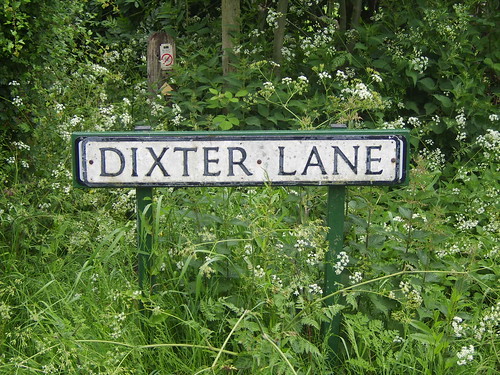OK, I admit...I cried!
29 April 2011
25 April 2011
Digging Amongst the Graves: Gardening at Highgate Cemetery
When I tell people that I enjoy poking around cemeteries the inevitable reaction is a pause, a startled sideways glance (no doubt seeking an avenue of escape), and cautious step back as they say, "Really??"
Really.
They can be fascinating places, cemeteries. Just think about all the history buried beneath your shoes. The really creepy ones provide endless inspiration for ghost stories and haunted fables. I don't go in for the blood-and-guts type stories that tinsel town churns out, but with a good imagination you can find mystery, intrigue, even romance.
Cemeteries and gardens have a lot in common. Cemeteries, like gardens, can be places of beauty designed to provoke an emotional response and the older ones are increasingly in need of care and management to maintain their spirit. So when the invitation to spend a day gardening with a volunteer group at historic Highgate Cemetery in north London presented itself, I signed on immediately! Even having perused the website, I was completely unprepared for the visions that greeted me.
Designed by architect Stephen Geary who appointed David Ramsey as landscape gardener, Highgate was opened in 1839 as part of a Parliamentary Act providing seven modern cemeteries (they were known as "The Magnificent Seven" back then) serving the London populace because the small church graveyards were becoming over-crowded and posed severe health hazards (ya think?).
Highgate is divided into two parts entered through the East Gate and West Gate respectively. Victorians much admired the new place and if it were appropriate to call a cemetery fashionable, Highgate became so (and when you think about it, by definition death is pretty fashionable. I mean, everyone does it...). Soon the land became a garden of Gothic graves with elaborate tombs and memorials sprouting up one after another. Situated on the side of a south-facing slope, it once commanded a majestic view of London.
Not so now.
Wikipedia states, "The cemetery's grounds are full of trees, shrubbery and wild flowers; all of which have been planted and grown without human influence", which is a polite way of saying it fell into a state of abandonment, decay, and near ruin. The sheep were no longer mowing the lawns, and the area began to revert to woodland. Self-sown ash, sycamore, holly, and oak trees struggle to take over, questing tendrils of ivy left unchecked made their way into tombs, disturbing the peaceful slumber of those within. Tree roots toppled monuments and swallowed up smaller, modest grave markers while invasive weeds that could tolerate the limited light from the canopy overhead choked out the grass and wildflowers.
With the onset of WW1 the men who maintained the immaculate grounds at Highgate were called up to action. Coupled with the desire for less elaborate and ostentatious funerals, the cemetery began to fall into a state of decline in the 1930s. Funds ran out in the early 1970's. In 1975 the Friends of Highgate Cemetery Trust was established and acquired ownership of the cemetery and it is they who now oversee management of the grounds. The cemetery is a Grade 1 English Heritage site and several of the chapels, monuments, tombs, and catacombs have also been listed.
A new management plan was adopted and is being tackled section by section with the view of maintaining the cemetery as a sanctuary for wildlife while preserving respect for the grave oweners, not a complete restoration to a Victorian cemetery (which would take millions of pounds and an army to accomplish). First a major clean up took place to remove fallen trees, dead wood, pruning up of low holly branches, and releasing statuary and sculpture from the ivy's embrace. The next phase included planting of native trees and shrubs such as Rowan (Sorbus aucuparia, appropriately known as the Tree of Life) and Ruscus aculeatus. Other hardy natives such as Carex pendula are controlled by thinning (the Collins Flower Guide notes the habitat of this particular sedge as 'damp woodlands on heavy soils, hedgerows, sides of ponds and stream.' I would like to add, 'grows happily over gravestones').
With light shining once again on the ground below, wildflowers have appeared and the blooms of Cow Parsley (Anthriscus sylvestris), Euphorbias, Forget-Me-Nots, Bluebells, and Scillas illuminate the landscape.
There is still much to be done, and it was heart breaking to see so many beautiful monuments shrouded in ivy that my Felcos were itching to have a go at the tangled stems but several of the stones have lead lettering embedded in them, and removal of the vines needs to be a slow and careful process to extract the invader and preserve the integrity of everything underneath. Surgery on the graves of the dead. What a thought! There is a delicacy that is required when working in such a densely populated area and it's a sure bet that when you feel the chunk of your spade on rock, the stone is some one's grave marker, not just a rock in the soil! It's also a sure bet that one reads way too many novels when one imagines the occupant of said grave raising the lid and mildly enquiring, "Do you mind? I'm trying to sleep!"

Volunteer work days are held once a month, and an organization called Go-London has gotten involved so that on the day I volunteered there were at least 20 of us hauling away dead brush, pulling weeds, rescuing the Ruscus, controlling invasives and bringing the place back to life, as it were.
Tours are offered to see the cemetery and if you're planning a day in London, I highly recommend it. Better yet, if you're a local, contact them and volunteer for one of the working parties. It was a great experience and a truly unique way to see one of the most mysterious and magical historical sites of London.
Really.
They can be fascinating places, cemeteries. Just think about all the history buried beneath your shoes. The really creepy ones provide endless inspiration for ghost stories and haunted fables. I don't go in for the blood-and-guts type stories that tinsel town churns out, but with a good imagination you can find mystery, intrigue, even romance.
Cemeteries and gardens have a lot in common. Cemeteries, like gardens, can be places of beauty designed to provoke an emotional response and the older ones are increasingly in need of care and management to maintain their spirit. So when the invitation to spend a day gardening with a volunteer group at historic Highgate Cemetery in north London presented itself, I signed on immediately! Even having perused the website, I was completely unprepared for the visions that greeted me.
Designed by architect Stephen Geary who appointed David Ramsey as landscape gardener, Highgate was opened in 1839 as part of a Parliamentary Act providing seven modern cemeteries (they were known as "The Magnificent Seven" back then) serving the London populace because the small church graveyards were becoming over-crowded and posed severe health hazards (ya think?).
Highgate is divided into two parts entered through the East Gate and West Gate respectively. Victorians much admired the new place and if it were appropriate to call a cemetery fashionable, Highgate became so (and when you think about it, by definition death is pretty fashionable. I mean, everyone does it...). Soon the land became a garden of Gothic graves with elaborate tombs and memorials sprouting up one after another. Situated on the side of a south-facing slope, it once commanded a majestic view of London.
 |
| Highgate, view from the terrace c. 1850 by R. Hind |
Not so now.
 |
| Note, this is the same Cedar of Lebanon tree shown in the 1850 illustration! |
With the onset of WW1 the men who maintained the immaculate grounds at Highgate were called up to action. Coupled with the desire for less elaborate and ostentatious funerals, the cemetery began to fall into a state of decline in the 1930s. Funds ran out in the early 1970's. In 1975 the Friends of Highgate Cemetery Trust was established and acquired ownership of the cemetery and it is they who now oversee management of the grounds. The cemetery is a Grade 1 English Heritage site and several of the chapels, monuments, tombs, and catacombs have also been listed.
A new management plan was adopted and is being tackled section by section with the view of maintaining the cemetery as a sanctuary for wildlife while preserving respect for the grave oweners, not a complete restoration to a Victorian cemetery (which would take millions of pounds and an army to accomplish). First a major clean up took place to remove fallen trees, dead wood, pruning up of low holly branches, and releasing statuary and sculpture from the ivy's embrace. The next phase included planting of native trees and shrubs such as Rowan (Sorbus aucuparia, appropriately known as the Tree of Life) and Ruscus aculeatus. Other hardy natives such as Carex pendula are controlled by thinning (the Collins Flower Guide notes the habitat of this particular sedge as 'damp woodlands on heavy soils, hedgerows, sides of ponds and stream.' I would like to add, 'grows happily over gravestones').
With light shining once again on the ground below, wildflowers have appeared and the blooms of Cow Parsley (Anthriscus sylvestris), Euphorbias, Forget-Me-Nots, Bluebells, and Scillas illuminate the landscape.
There is still much to be done, and it was heart breaking to see so many beautiful monuments shrouded in ivy that my Felcos were itching to have a go at the tangled stems but several of the stones have lead lettering embedded in them, and removal of the vines needs to be a slow and careful process to extract the invader and preserve the integrity of everything underneath. Surgery on the graves of the dead. What a thought! There is a delicacy that is required when working in such a densely populated area and it's a sure bet that when you feel the chunk of your spade on rock, the stone is some one's grave marker, not just a rock in the soil! It's also a sure bet that one reads way too many novels when one imagines the occupant of said grave raising the lid and mildly enquiring, "Do you mind? I'm trying to sleep!"

Volunteer work days are held once a month, and an organization called Go-London has gotten involved so that on the day I volunteered there were at least 20 of us hauling away dead brush, pulling weeds, rescuing the Ruscus, controlling invasives and bringing the place back to life, as it were.
Tours are offered to see the cemetery and if you're planning a day in London, I highly recommend it. Better yet, if you're a local, contact them and volunteer for one of the working parties. It was a great experience and a truly unique way to see one of the most mysterious and magical historical sites of London.
Labels:
cemetery,
Highgate,
invasive species,
self-sowers
07 April 2011
You Have to Start Somewhere
So much has happened since we arrived at Great Dixter it's difficult to pick just one, or even two, subjects to elaborate on because, really, if I were to dive in and pull one out and tell you all about it we'd be here for days! Days, I tell you!
Like the day we accompanied our new friend James, the first Christopher Lloyd Scholar here at Dixter, to the RHS Garden Wisley and how enchanted we all were with the Alpine House. Or the day we visited Beth Chatto's garden and met Beth (how can a woman so small have so much energy?) who gave us all a hug! And speaking of energy, I could go on at great length about working with the likes of Fergus Garrett, who leaves the Energizer Bunny absolutely knackered and begging for a breather. Then there was the day we went to Sissinghurst Garden just at closing and were permitted to wander the garden at will until it was too dark to see anything. How about a magical morning walk in the woods with Dan Hinkley to view the wild daffodil in its native habitat? And I can't forget the perfect sunny Sunday that James, Emma, and I explored the public footpaths from Dixter to Bodiam Castle and enjoyed a cream tea with one of the retired volunteers there who was full of fantastic stories and wonderful information of the area.
And it's only been a month! Where shall I possibly begin?
As Fergus says, you have to start somewhere so I'll start at the beginning:
The estate of Dixter appears in the books as far back as the 1200's. That's the 13th century, or almost 800 years ago. However you look at it, Dixter's been here for a reeeeeally long time! It was owned by a succession of noble gentlemen who, in one way or another, had garnered favor with the Monarchy and accumulated varieties of titles, lands, wealth, and sons-in-law. They had interesting names but the one we're most interested in is Lloyd, which enters the record book in 1910 when the estate was purchased as a new family home for Nathaniel and Daisy Lloyd and their growing brood. By this time the original 15th century timber framed hall house - built sometime around 1450 - and the surrounding farmland had been neglected and on the market for over ten years.
The Lloyd's hired the well-know architect Edwin Lutyens to restore and enlarge the dwelling, which he did by incorporating another hall - this one much newer and somewhat humbler than the Great Hall, dating to about 1500 - the timbers of which were numbered, disassembled, transported, and reassembled at Dixter with a modern kitchen and bedroom wing joining the two timbered structures. Modern amenities such as central heat, electricity, and indoor plumbing were added as well, enabling the earth closets in use at the time to be replaced with water closets*.
Lutyens also laid out the framework of the gardens with decided input from Mr. Lloyd and it was his wife Daisy who became the first real gardener at Dixter. Of their six children only the youngest, Christopher (1921-2006) showed an inclination to gardening and it was he who made the garden famous by experimenting with plants and plant combinations then writing about them and the garden in his inimitable style. He was simultaneously a maverick and a trendsetter in the gardening world (putting pink and yellow together just wasn't done, darling!).
Dixter, under the green fingers of Daisy and Christo was really a garden ahead of its time: Daisy planted the first wildflower meadows at Dixter, which Christo expanded. Now, wildlife studies have found that the plant and insect species formerly so common in the UK have diminished in alarming degrees because of the reduction of natural meadowland. Christo's head gardener Fergus is continuing to expand the meadows at Dixter which has encouraged an increase in population of both moths and butterflies as well as the rare native meadow orchid, happily colonizing in Dixter's long grass.
Dixter has always made use of its own compost, taking the cuttings, clippings, and debris from garden and kitchen, heaping it all into massive piles and waiting patiently for nature to do its thing until the compost is ready to use in the garden. Large iron tubs in the nursery collect rain water and an underground tank collects well water run down from the high meadow, fed by gravity, for use in watering nursery plants and the plethora of pot displays in the garden.
Plants in the garden are buttressed by poles, canes, and pea sticks that come from the Dixter coppice woods or the garden itself. Everything is used that possibly can be, little is wasted, and everything that can be reused, is. This all began 100 years ago, before such a thing as conservation was hip and before the word 'sustainability' began buzzing around like a vibrating mobile phone. Not bad for a garden that is still run the 'old way', is it?
As with any family that owns a large estate there was some drama involved in procuring Dixter after Christopher's death but it has been secured and is now run by the Great Dixter Charitable Trust while the garden is managed by Fergus Garrett and his team of amazing gardeners in the way Christo gardened. It is still seen very much as a garden going forward, not sealed in aspic to preserve it forever unchanged, and the recurring theme regarding new plants and combinations is "let's see what happens".
It's a hugely dynamic garden, celebrating just over 100 years of cultivation. It's a pretty amazing place to be and in the months to come I'll try to steal a few moments between adventures to regale you with tales and information. For now, have a look at some pretty pictures or Google 'earth closet' and see if I'm not telling you the truth!
*Earth closets were invented in the 1860's by a Mr. Moule and basically constituted a commode with a pail full of earth under it. This was a major boon to housekeeping and if you believe the memoirs of certain house maids, carrying a bucket of soiled earth down to fertilize** the garden was infinitely preferable to emptying chamber pots. This invention is being renewed in light of the new "green movement" as self-composting toilets.
**Lest you utter a moue of distaste at the thought of human waste being used as fertilizer, allow me to direct you to the ingredient list of some bagged compost products. Some of them contain "bio solids", more commonly known as sewage sludge. Makes you think about what you're putting in your garden, doesn't it?
Like the day we accompanied our new friend James, the first Christopher Lloyd Scholar here at Dixter, to the RHS Garden Wisley and how enchanted we all were with the Alpine House. Or the day we visited Beth Chatto's garden and met Beth (how can a woman so small have so much energy?) who gave us all a hug! And speaking of energy, I could go on at great length about working with the likes of Fergus Garrett, who leaves the Energizer Bunny absolutely knackered and begging for a breather. Then there was the day we went to Sissinghurst Garden just at closing and were permitted to wander the garden at will until it was too dark to see anything. How about a magical morning walk in the woods with Dan Hinkley to view the wild daffodil in its native habitat? And I can't forget the perfect sunny Sunday that James, Emma, and I explored the public footpaths from Dixter to Bodiam Castle and enjoyed a cream tea with one of the retired volunteers there who was full of fantastic stories and wonderful information of the area.
And it's only been a month! Where shall I possibly begin?
As Fergus says, you have to start somewhere so I'll start at the beginning:
The estate of Dixter appears in the books as far back as the 1200's. That's the 13th century, or almost 800 years ago. However you look at it, Dixter's been here for a reeeeeally long time! It was owned by a succession of noble gentlemen who, in one way or another, had garnered favor with the Monarchy and accumulated varieties of titles, lands, wealth, and sons-in-law. They had interesting names but the one we're most interested in is Lloyd, which enters the record book in 1910 when the estate was purchased as a new family home for Nathaniel and Daisy Lloyd and their growing brood. By this time the original 15th century timber framed hall house - built sometime around 1450 - and the surrounding farmland had been neglected and on the market for over ten years.
The Lloyd's hired the well-know architect Edwin Lutyens to restore and enlarge the dwelling, which he did by incorporating another hall - this one much newer and somewhat humbler than the Great Hall, dating to about 1500 - the timbers of which were numbered, disassembled, transported, and reassembled at Dixter with a modern kitchen and bedroom wing joining the two timbered structures. Modern amenities such as central heat, electricity, and indoor plumbing were added as well, enabling the earth closets in use at the time to be replaced with water closets*.
Lutyens also laid out the framework of the gardens with decided input from Mr. Lloyd and it was his wife Daisy who became the first real gardener at Dixter. Of their six children only the youngest, Christopher (1921-2006) showed an inclination to gardening and it was he who made the garden famous by experimenting with plants and plant combinations then writing about them and the garden in his inimitable style. He was simultaneously a maverick and a trendsetter in the gardening world (putting pink and yellow together just wasn't done, darling!).
Dixter, under the green fingers of Daisy and Christo was really a garden ahead of its time: Daisy planted the first wildflower meadows at Dixter, which Christo expanded. Now, wildlife studies have found that the plant and insect species formerly so common in the UK have diminished in alarming degrees because of the reduction of natural meadowland. Christo's head gardener Fergus is continuing to expand the meadows at Dixter which has encouraged an increase in population of both moths and butterflies as well as the rare native meadow orchid, happily colonizing in Dixter's long grass.
Dixter has always made use of its own compost, taking the cuttings, clippings, and debris from garden and kitchen, heaping it all into massive piles and waiting patiently for nature to do its thing until the compost is ready to use in the garden. Large iron tubs in the nursery collect rain water and an underground tank collects well water run down from the high meadow, fed by gravity, for use in watering nursery plants and the plethora of pot displays in the garden.
Plants in the garden are buttressed by poles, canes, and pea sticks that come from the Dixter coppice woods or the garden itself. Everything is used that possibly can be, little is wasted, and everything that can be reused, is. This all began 100 years ago, before such a thing as conservation was hip and before the word 'sustainability' began buzzing around like a vibrating mobile phone. Not bad for a garden that is still run the 'old way', is it?
As with any family that owns a large estate there was some drama involved in procuring Dixter after Christopher's death but it has been secured and is now run by the Great Dixter Charitable Trust while the garden is managed by Fergus Garrett and his team of amazing gardeners in the way Christo gardened. It is still seen very much as a garden going forward, not sealed in aspic to preserve it forever unchanged, and the recurring theme regarding new plants and combinations is "let's see what happens".
It's a hugely dynamic garden, celebrating just over 100 years of cultivation. It's a pretty amazing place to be and in the months to come I'll try to steal a few moments between adventures to regale you with tales and information. For now, have a look at some pretty pictures or Google 'earth closet' and see if I'm not telling you the truth!
 |
| Entrance to Great Dixter - this is part of the original 1450 manor house restored by Lutyens |
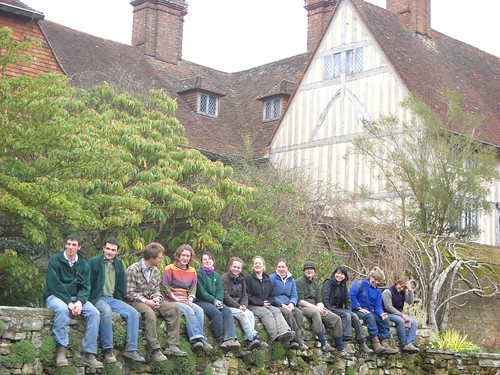 |
| Horticulture students at Dixter for a volunteer weekend are seated on the wall of the Terrace with the imported Benenden Hall looming in the background |
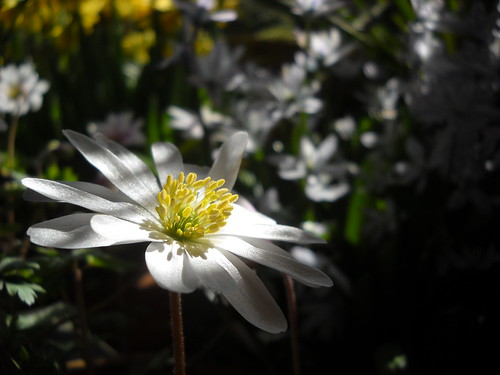 |
| Anemone blooming in a pot display on the porch |
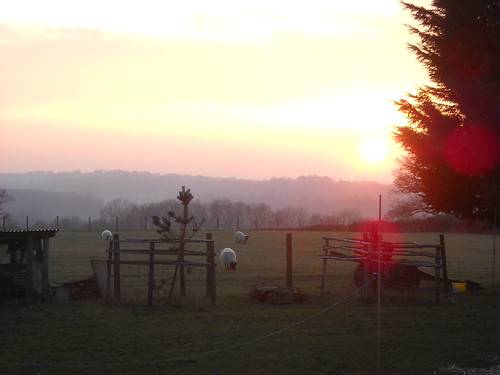 |
| Dixter's sheep (part of the meadow management crew) |
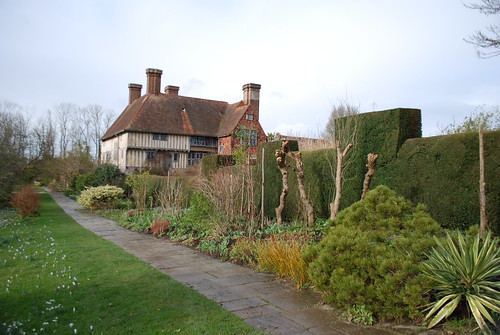 |
| The famous Long Border in early spring |
*Earth closets were invented in the 1860's by a Mr. Moule and basically constituted a commode with a pail full of earth under it. This was a major boon to housekeeping and if you believe the memoirs of certain house maids, carrying a bucket of soiled earth down to fertilize** the garden was infinitely preferable to emptying chamber pots. This invention is being renewed in light of the new "green movement" as self-composting toilets.
**Lest you utter a moue of distaste at the thought of human waste being used as fertilizer, allow me to direct you to the ingredient list of some bagged compost products. Some of them contain "bio solids", more commonly known as sewage sludge. Makes you think about what you're putting in your garden, doesn't it?
Labels:
Christopher Lloyd,
Edwin Lutyens,
Great Dixter
03 April 2011
On Pruning
Beth Chatto: "Take the old men out!"
Fergus Garrett: "You have to start somewhere"
Emma Seniuk: "Life's too short to f**k around!"
Fergus Garrett: "You have to start somewhere"
Emma Seniuk: "Life's too short to f**k around!"
Labels:
pruning
Subscribe to:
Posts (Atom)



